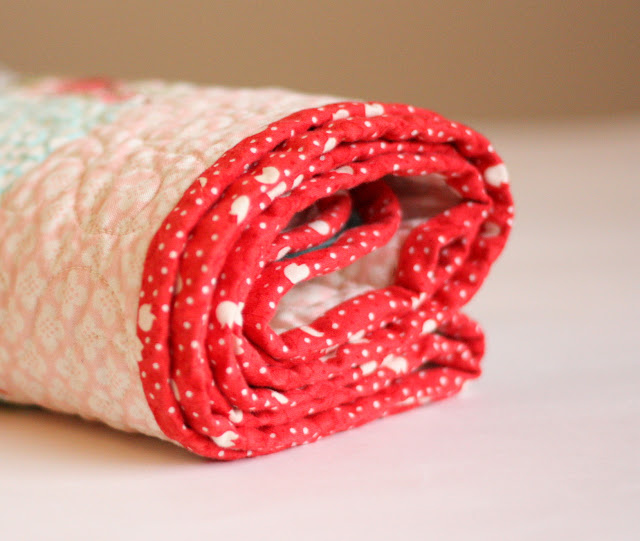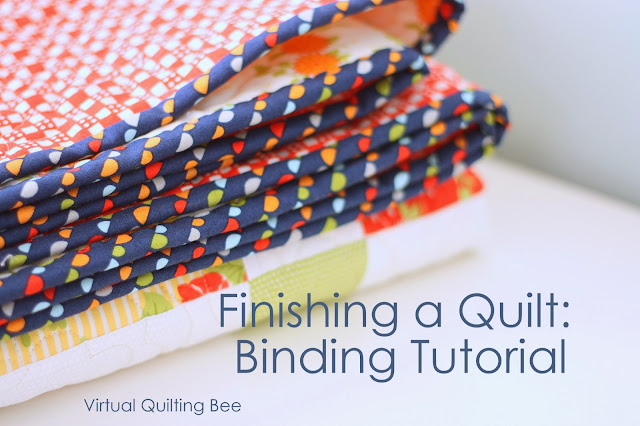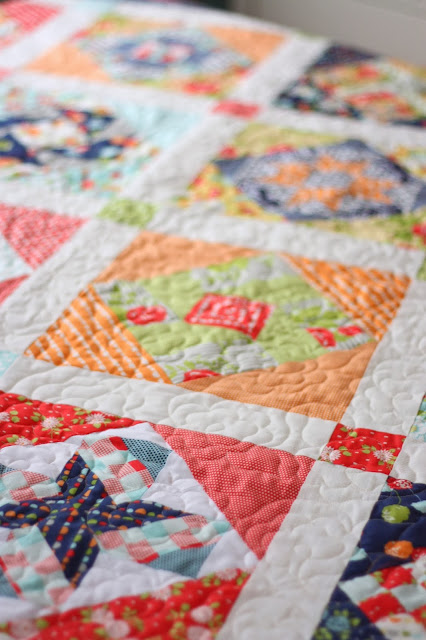Monday, December 2, 2013
For our final installment of the Virtual Quilting Bee, let's talk about finishing - or binding - a quilt. This is adding that final edge to cover the raw edges of the fabric after the quilt has been quilted. One option is to roll over the back fabric edges and sew them to the front to finish that edge. I personally like the look of a separate binding - gives it a clean finish. It's also a fun excuse to use another fabric and use it to finish off the final design.
Cutting the fabric: I like to do a double binding on my quilts - meaning there are two layers to the binding edge. This gives it an extra layer of fabric to hold up against wear and tear. To get this I cut my binding strips 2 1/2" wide. You can cut your strips across the width of the fabric yardage, or cut them on the bias, which means to cut them diagonally across the fabric.
There are pros and cons to both methods. Cutting straight-edge is easier with less fabric waste. Bias bindings are sturdier because the fabric edge not being on the straight of grain. If you are going to have any kind of curved edge to your quilt, you will need a bias binding.
 I talk more about Bias Bindings in this post. Jaybird Quilts also has an excellent tutorial about Bias Binding and how to cut continuous bias binding.
I talk more about Bias Bindings in this post. Jaybird Quilts also has an excellent tutorial about Bias Binding and how to cut continuous bias binding.
One determining factor for whether you cut straight edge or bias binding is the fabric itself. You may want to put a stripe or a gingham on the bias to make a diagonal design for the binding. The fabric I chose already had a diagonal motif, so I choose the straight edge to keep the diagonal design as is.
When cutting a straight edge binding (or any straight strips of fabric) before you cut, make sure your selvage edges line up straight with each other. This may require refolding the fabric and pressing a new center fold. As you can see in the picture above, the fabric came off the bolt with the selvage edges not matched up.
When selvage edges are matched up and straight, line up the center fold on a straight line on your quilting mat (see arrow above) and carefully trim the edge to create a straight edge and therefore, a straight strip of fabric. (This step is important, otherwise your fabric strip could end up V shaped.)
I generally cut my binding strips 2 1/2" wide, unless it's a small quilt when I might cut them 2 1/4" wide.
For the Virtual Quilting Bee Quilt cut 7 strips 2 1/2" wide x 42" (or width of fabric) - or if you are using bias binding, you will need 275" of continuous bias binding.
Trim selvage edges off of all strips and sew them end to end to create one long strip, pressing seams open (so you don't have bulk). Fold in half lengthwise and press.
Using a ruler and rotary cutter and the quilt top as a guide, trim the excess batting and backing layers so that all edges of the quilt are the same. Be careful to keep the quilt's sides square.
Some quick thoughts on washing your quilt: I personally love to machine wash my machine-quilted-quilts when they are done because they soften up a lot and have a more antiqued, crinkly look. If you've used cotton batting they are likely to shrink slightly more. (I don't machine-wash hand quilted quilts as liberally.)
I wash the quilts on a gentle cycle with a very mild soap and dry on a low heat setting. If you're at all worried about color bleeding, the first time you wash a quilt throw in a Shout Color Catcher (available in the laundry aisle at the grocery store). Remember from our discussion on choosing fabrics for quilts, if you're using high-quality quilt fabrics, you should have very little worry about colors bleeding.
If you have any additional questions about finishing a quilt, leave a comment and I will answer in them in the comments section below.
And that wraps up our Virtual Quilting Bee series! For links to all the the posts in this series visit the Virtual Quilting Bee page. I'll have a few more shots of both of the quilts together once I get the Kona version back from the quilter. And I'm thinking it would be fun to have a little party to show off the quilts that have been put together using these tutorials. Let's wait until after the busy holiday season. So look for an announcement at the beginning of February!
Thanks so much to all who played along as well as Moda and Robert Kaufman for sponsoring the fabrics I used.
If you are looking for Happy Go Lucky fabrics - the fabrics I used in this quilt - they are still available at The Little Fabric Shop and Poppy Seed Fabrics.
http://www.diaryofaquilter.com/2013/12/how-to-finish-and-bind-quilt.html
When I first learned to quilt, I was really nervous about learning to bind a quilt - and was amazed once I did learn how easy it was to make a really good looking binding. Now it's one of my favorite parts of quilting.
There are pros and cons to both methods. Cutting straight-edge is easier with less fabric waste. Bias bindings are sturdier because the fabric edge not being on the straight of grain. If you are going to have any kind of curved edge to your quilt, you will need a bias binding.

When cutting a straight edge binding (or any straight strips of fabric) before you cut, make sure your selvage edges line up straight with each other. This may require refolding the fabric and pressing a new center fold. As you can see in the picture above, the fabric came off the bolt with the selvage edges not matched up.
When selvage edges are matched up and straight, line up the center fold on a straight line on your quilting mat (see arrow above) and carefully trim the edge to create a straight edge and therefore, a straight strip of fabric. (This step is important, otherwise your fabric strip could end up V shaped.)
I generally cut my binding strips 2 1/2" wide, unless it's a small quilt when I might cut them 2 1/4" wide.
For the Virtual Quilting Bee Quilt cut 7 strips 2 1/2" wide x 42" (or width of fabric) - or if you are using bias binding, you will need 275" of continuous bias binding.
Trim selvage edges off of all strips and sew them end to end to create one long strip, pressing seams open (so you don't have bulk). Fold in half lengthwise and press.
Using a ruler and rotary cutter and the quilt top as a guide, trim the excess batting and backing layers so that all edges of the quilt are the same. Be careful to keep the quilt's sides square.
Pin the raw edges (non-folded-edge) to the raw outside edges of the quilt front. This is personal preference, but I then like to pin the entire binding to the quilt before I sew it down. This helps keep the binding taught and prevents potential wavy quilt edges later.
To create a mitered corner on the binding follow the steps above (starting top left): When you come to the corner put a pin in the corner at a 45 degree angle. Fold strip to the side at that same 45 degree angle. Now fold the strip back on it self with the fold at the first edge of the quilt and matching up the binding edges to the edge of the second side of the quilt. Place one more pin on the new side at a 45 degree angle. This will create a little triangle flap of fabric in the corner. Repeat at all four corners.
When the strip gets back around to the beginning fold the ends down so that the strips meet-up. Press with your iron to make a crease at both folds.
Trim both ends to 1/4" away from the folds. Remove pins, match up strips right sides together, pin, and sew seam right on pressed crease. Press seam open, refold strip and pin in place.
Sew binding in place using a 1/4" seam allowance. I highly recommend using a walking foot if you have one.

When you get to the corner keep flap down and sew until you are 1/4" away from the corner. Lift the needle, but do not cut the thread. Rotate the quilt and flip the little triangle flap so that it lies the opposite direction. Begin sewing next seam right at the edge of the last side. Repeat at all four corners.
When your binding is sewn to your quilt front fold the folded edge of the binding over to the back of the quilt and pin or clip in place. (I have finally started using Clover Wonder Clips which I really love - and so do the feet of my family members. Less worry about stray pins ending up in the carpet as I drag the quilt around to hand-quilt it.)
which I really love - and so do the feet of my family members. Less worry about stray pins ending up in the carpet as I drag the quilt around to hand-quilt it.)
I suggest a matching thread and a sturdy needle. Hand binding goes much more quickly if you have a needle that is longer and heavier - and I can do it with out a thimble with a heavier needle too.
After putting a knot in the end of the thread, hide the knot at the edge of the quilt where the binding will fold over and hide it. Bring the needle through the very bottom edge of the bias strip and tack it down on the backing fabric, right underneath where the needle came through. Then slide the needle through the backing fabric, behind the binding strip bringing the needle out the bottom edge again. This creates a blind stitch. Repeat!
For more perspective and additional photos of the same method see this Binding a Quilt tutorial. Jaybird Quilts also has an excellent perspective on binding here, as well as information about calculating fabric requirements for binding.
The quilting on this quilt was done by Melissa of Sew Shabby Quilting.
Personally, I really like binding a quilt by hand because not only does it create a clean, blind finish, but it's also mindless sewing and pretty much the only time I sit down to watch a movie or TV. But binding a quilt by machine can be efficient and look equally clean and tidy. For more tips and explanation I have a Machine Binding tutorial here. There is another great machine binding tutorial by Cluck Cluck Sew.
I wash the quilts on a gentle cycle with a very mild soap and dry on a low heat setting. If you're at all worried about color bleeding, the first time you wash a quilt throw in a Shout Color Catcher (available in the laundry aisle at the grocery store). Remember from our discussion on choosing fabrics for quilts, if you're using high-quality quilt fabrics, you should have very little worry about colors bleeding.
If you have any additional questions about finishing a quilt, leave a comment and I will answer in them in the comments section below.
And that wraps up our Virtual Quilting Bee series! For links to all the the posts in this series visit the Virtual Quilting Bee page. I'll have a few more shots of both of the quilts together once I get the Kona version back from the quilter. And I'm thinking it would be fun to have a little party to show off the quilts that have been put together using these tutorials. Let's wait until after the busy holiday season. So look for an announcement at the beginning of February!
Thanks so much to all who played along as well as Moda and Robert Kaufman for sponsoring the fabrics I used.
If you are looking for Happy Go Lucky fabrics - the fabrics I used in this quilt - they are still available at The Little Fabric Shop and Poppy Seed Fabrics.
http://www.diaryofaquilter.com/2013/12/how-to-finish-and-bind-quilt.html

















No comments:
Post a Comment